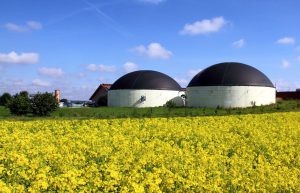Biogas can be produced from biomass by utilizing bacteria under anaerobic conditions via a series of processing steps. Feedstock can vary, but is often corn and grain silage or manure.

Production of biogas
The bulk of the biomass feedstock is dumped into a big container. The decomposition processes take place in the container. According to current state-of-the-art not all forms of biomass can be used to biogas production. In particular woody biomass cannot be transformed into biogas easily, as the involved bacteria have difficulties in decomposing ligneous molecule structures.
The container is shielded from the ambient air. In addition, it is heated and its exterior is equipped with motors to drive the stirrer inside. Heating is necessary as the involved bacteria are mesophile (28-40°C) and work at around 37°C. A higher temperature also implies a higher speed of the reactions within the container.
Most biogas production plants in Germany apply the principle of wet fermentation. Therefore the container is also filled with water and allows for proper mixing of the contained material by the stirrer. Thus, the process can operate continuously.
The production of biogas from biomass basically requires four subsequent biochemical processes. For the sake of simplification, one can say that one bacterial strain is responsible for one of the four processes. In order to provide ideal conditions, i.e. temperature and ph-value, for each of the respective bacterial strains each of the four processes should be operated in a different container. Due to economic constraints, only one container is utilized. All processes take place simultaneously.
The four processes of biogas production are:
- Hydrolysis (1) – Biodegradation in aqueous solution
- Acidogenesis (2) – Development of acids
- Acetogenesis (3) – Development of acetic acid
- Methanogenesis (4) – Formation of methane.
Biomass is directed into an airtight container and is enriched with sufficient water. The bacteria set off to split fats, proteins and carbohydrates (1). Acidogenic bacteria metabolize the degraded products and transform them into acids (2). Those acids are then processed by acedogenic bacteria into acetic acid (3). In the last phase the acetic acid is split into methane as well as carbon dioxide and water (4).
The processes depend and support each other. During phase 4, heat is being released, while phase 3 only occurs when heat is injected into the system
Utilization of biogas
Methane and carbon dioxide accumulate in the container (also called fermenter). Along with the residues of the fermentation they are guided into a post-fermentation facility. In order guarantee continuous production, the fermenter is filled as soon as gas production ceases to occur. By that time the processes are not yet finished, but the biomass is still fermenting.
Resulting biogas can then be sucked from the gas storage and may be used for running a combined heat and power (CHP) plant. In such a CHP plant both heat and electricity are generated. The CHP unit generally consists of a motor which is connected to a generator. The electricity is fed into the public grid, while some part of the heat produced can be used to meet the heating requirements of the biogas production unit. If there is still heat left, it can be used in district heating grids.
When the biomass residues have completely been fermented, i.e. if no new biogas is being formed in the process, the biomass can be utilized as a fertilizer.
The biogas also be „upgraded“ to meet the quality standards for natural gas. This includes the removal of several undesirable components, such as CO2, hydrogen sulphide and water.



